Related Research Articles

Digital microfluidics (DMF) is a platform for lab-on-a-chip systems that is based upon the manipulation of microdroplets. Droplets are dispensed, moved, stored, mixed, reacted, or analyzed on a platform with a set of insulated electrodes. Digital microfluidics can be used together with analytical analysis procedures such as mass spectrometry, colorimetry, electrochemical, and electrochemiluminescense.
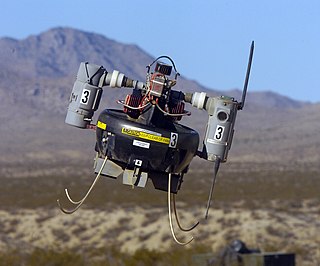
A micro air vehicle (MAV), or micro aerial vehicle, is a class of man-portable miniature UAVs whose size enables them to be used in low-altitude, close-in support operations. Modern MAVs can be as small as 5 centimeters - compare Nano Air Vehicle. Development is driven by commercial, research, government, and military organizations; with insect-sized aircraft reportedly expected in the future. The small craft allow remote observation of hazardous environments or of areas inaccessible to ground vehicles. Hobbyists have designed MAVs for applications such as aerial robotics contests and aerial photography. MAVs can offer autonomous modes of flight.
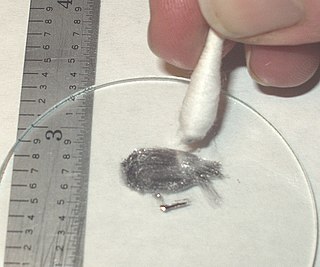
Galinstan is a brand name for an alloy composed of gallium, indium, and tin which melts at −19 °C (−2 °F) and is thus liquid at room temperature. In scientific literature, galinstan is also used to denote the eutectic alloy of gallium, indium, and tin, which melts at around +11 °C (52 °F). The commercial product Galinstan is not a eutectic alloy, but a near eutectic alloy. Additionally, it likely has added flux to improve flowability, to reduce melting temperature, and to reduce surface tension.

Electrorheological (ER) fluids are suspensions of extremely fine non-conducting but electrically active particles in an electrically insulating fluid. The apparent viscosity of these fluids changes reversibly by an order of up to 100,000 in response to an electric field. For example, a typical ER fluid can go from the consistency of a liquid to that of a gel, and back, with response times on the order of milliseconds. The effect is sometimes called the Winslow effect after its discoverer, the American inventor Willis Winslow, who obtained a US patent on the effect in 1947 and wrote an article published in 1949.

Magnetic force microscopy (MFM) is a variety of atomic force microscopy, in which a sharp magnetized tip scans a magnetic sample; the tip-sample magnetic interactions are detected and used to reconstruct the magnetic structure of the sample surface. Many kinds of magnetic interactions are measured by MFM, including magnetic dipole–dipole interaction. MFM scanning often uses non-contact atomic force microscopy (NC-AFM) and is considered to be non-destructive with respect to the test sample.
Scopulae, or scopula pads, are dense tufts of hair at the end of a spiders's legs. They are found mostly on hunting spiders, for example Salticidae and Sparassidae. Scopulae consist of microscopic hairs, known as setae, which are each covered in even smaller hairs called setules or "end feet", resulting in a large contact area.

A mobile robot is an automatic machine that is capable of locomotion. Mobile robotics is usually considered to be a subfield of robotics and information engineering.
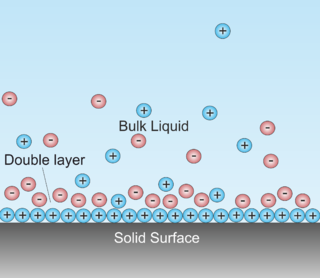
In surface science, a double layer is a structure that appears on the surface of an object when it is exposed to a fluid. The object might be a solid particle, a gas bubble, a liquid droplet, or a porous body. The DL refers to two parallel layers of charge surrounding the object. The first layer, the surface charge, consists of ions which are adsorbed onto the object due to chemical interactions. The second layer is composed of ions attracted to the surface charge via the Coulomb force, electrically screening the first layer. This second layer is loosely associated with the object. It is made of free ions that move in the fluid under the influence of electric attraction and thermal motion rather than being firmly anchored. It is thus called the "diffuse layer".

A biointerface is the region of contact between a biomolecule, cell, biological tissue or living organism or organic material considered living with another biomaterial or inorganic/organic material. The motivation for biointerface science stems from the urgent need to increase the understanding of interactions between biomolecules and surfaces. The behavior of complex macromolecular systems at materials interfaces are important in the fields of biology, biotechnology, diagnostics, and medicine. Biointerface science is a multidisciplinary field in which biochemists who synthesize novel classes of biomolecules cooperate with scientists who have developed the tools to position biomolecules with molecular precision, scientists who have developed new spectroscopic techniques to interrogate these molecules at the solid-liquid interface, and people who integrate these into functional devices. Well-designed biointerfaces would facilitate desirable interactions by providing optimized surfaces where biological matter can interact with other inorganic or organic materials, such as by promoting cell and tissue adhesion onto a surface.
Optoelectrofluidics, also known as optically induced electrohydrodynamics, refers to the study of the motions of particles or molecules and their interactions with optically-induced electric field and the surrounding fluid.
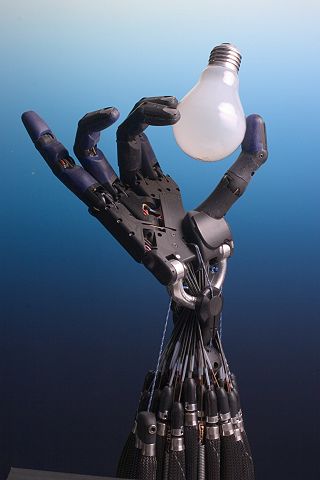
Robotics is the interdisciplinary study and practice of the design, construction, operation, and use of robots.
An end effector is the device at the end of a robotic arm, designed to interact with the environment. The exact nature of this device depends on the application of the robot.
Evolutionary developmental robotics refers to methodologies that systematically integrate evolutionary robotics, epigenetic robotics and morphogenetic robotics to study the evolution, physical and mental development and learning of natural intelligent systems in robotic systems. The field was formally suggested and fully discussed in a published paper and further discussed in a published dialogue.

Altius Space Machines is a subsidiary company of Voyager Space Holdings, based in Broomfield, CO dedicated to engineering the future in Aerospace.

Bio-inspired robotic locomotion is a fairly new subcategory of bio-inspired design. It is about learning concepts from nature and applying them to the design of real-world engineered systems. More specifically, this field is about making robots that are inspired by biological systems, including Biomimicry. Biomimicry is copying from nature while bio-inspired design is learning from nature and making a mechanism that is simpler and more effective than the system observed in nature. Biomimicry has led to the development of a different branch of robotics called soft robotics. The biological systems have been optimized for specific tasks according to their habitat. However, they are multifunctional and are not designed for only one specific functionality. Bio-inspired robotics is about studying biological systems, and looking for the mechanisms that may solve a problem in the engineering field. The designer should then try to simplify and enhance that mechanism for the specific task of interest. Bio-inspired roboticists are usually interested in biosensors, bioactuators, or biomaterials. Most of the robots have some type of locomotion system. Thus, in this article different modes of animal locomotion and few examples of the corresponding bio-inspired robots are introduced.
Masakatsu G. Fujie is a Japanese scientist who has played a major role in cutting-edge research in biomedical engineering. He has been responsible for many advances in the field of robotics.
Tendon-driven robots (TDR) are robots whose limbs mimic biological musculoskeletal systems. They use plastic straps to mimic muscles and tendons. Such robots are claimed to move in a "more natural" way than traditional robots that use rigid metal or plastic limbs controlled by geared actuators. TDRs can also help understand how biomechanics relates to embodied intelligence and cognition.
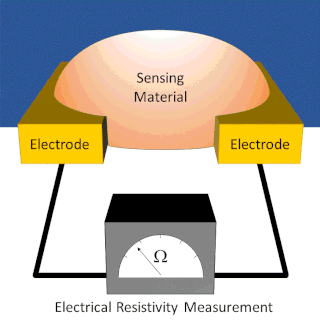
A chemiresistor is a material that changes its electrical resistance in response to changes in the nearby chemical environment. Chemiresistors are a class of chemical sensors that rely on the direct chemical interaction between the sensing material and the analyte. The sensing material and the analyte can interact by covalent bonding, hydrogen bonding, or molecular recognition. Several different materials have chemiresistor properties: semiconducting metal oxides, some conductive polymers, and nanomaterials like graphene, carbon nanotubes and nanoparticles. Typically these materials are used as partially selective sensors in devices like electronic tongues or electronic noses.

Soft robotics is a subfield of robotics that concerns the design, control, and fabrication of robots composed of compliant materials, instead of rigid links. In contrast to rigid-bodied robots built from metals, ceramics and hard plastics, the compliance of soft robots can improve their safety when working in close contact with humans.
References
- ↑ "Electroadhesive Surface-Climbing Robots". SRI International . Retrieved 2013-07-01.
- ↑ Wei, Daiyue; Xiong, Quan; Dong, Jiufeng; Wang, Huacen; Liang, Xuanquan; Tang, Shiyu; Xu, Xinwei; Wang, Hongqiang; Wang, Hong (2023-06-01). "Electrostatic Adhesion Clutch with Superhigh Force Density Achieved by MXene-Poly(Vinylidene Fluoride–Trifluoroethylene–Chlorotrifluoroethylene) Composites". Soft Robotics. 10 (3): 482–492. doi:10.1089/soro.2022.0013. ISSN 2169-5172.
- ↑ "Electroadhesion". SRI International . Retrieved 2014-05-08.
- ↑ "A brief history of Electroadhesion" (PDF). mechatronics.org . Retrieved 2014-01-06.
- ↑ Wang, Hongqiang. "Comprehensive Model of Laminar Jamming Variable Stiffness Driven by Electrostatic Adhesion_supp2-3319650.mp4". dx.doi.org. Retrieved 2024-04-24.
- ↑ Schaler, Ethan W.; Ruffatto, Donald; Glick, Paul; White, Victor; Parness, Aaron (September 2017). "An electrostatic gripper for flexible objects". 2017 IEEE/RSJ International Conference on Intelligent Robots and Systems (IROS). IEEE. doi:10.1109/iros.2017.8202289.
- ↑ Wang, Hongqiang; Yamamoto, Akio (2017). "Analyses and solutions for the buckling of thin and flexible electrostatic inchworm climbing robots". IEEE Transactions on Robotics. 33 (4): 889–900.
- ↑ Xiong, Quan; Liang, Xuanquan; Wei, Daiyue; Wang, Huacen; Zhu, Renjie; Wang, Ting; Mao, Jianjun; Wang, Hongqiang (2022). "So-EAGlove: VR haptic glove rendering softness sensation with force-tunable electrostatic adhesive brakes". IEEE Transactions on Robotics. 38 (6): 3450–3462.
- ↑ Chen, Cheng; Fan, Dongliang; Ren, Hongliang; Wang, Hongqiang (2023). "Comprehensive Model of Laminar Jamming Variable Stiffness Driven by Electrostatic Adhesion". IEEE/ASME Transactions on Mechatronics.